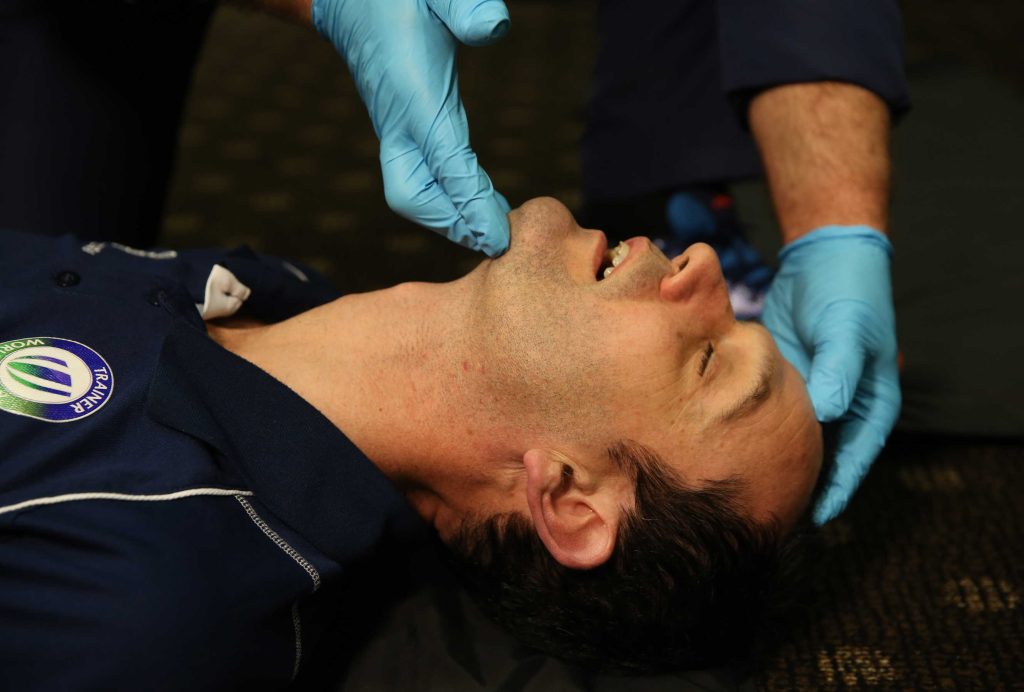When seconds count in emergency situations, proper airway management can mean the difference between life and death. For healthcare providers and first responders trained in CPR and First Aid, understanding how to effectively use Bag-Valve-Mask (BVM) ventilation in conjunction with proper airway positioning techniques is crucial. This article explores the critical combination of jaw-thrust and head-tilt maneuvers when using BVMs, providing essential knowledge for anyone seeking to enhance their lifesaving skills.
The Foundation of Effective CPR: Airway Management
Before using an AED or performing chest compressions, establishing a patent airway is the priority in any resuscitation effort. The American Heart Association emphasizes this as the “A” in the ABC (Airway, Breathing, Circulation) approach to CPR. Without a clear airway, other interventions may prove ineffective.
Airway obstruction can occur in unconscious patients when the tongue relaxes and falls backward, blocking the pharynx. This is where proper positioning techniques become essential. Two primary methods—the head-tilt/chin-lift and the jaw-thrust maneuvers—are standard components of First Aid training, each with specific applications depending on the situation.
Understanding Head-Tilt/Chin-Lift in First Aid Scenarios
The head-tilt/chin-lift maneuver is typically the first approach taught in basic CPR courses. This technique involves:
- Placing one hand on the victim’s forehead and applying firm backward pressure to tilt the head back
- Using the fingers of the other hand to lift the chin forward
This positioning helps move the tongue away from the back of the throat, opening the airway. However, this technique should be used with caution or avoided in cases of suspected spinal injury, as the movement can potentially exacerbate spinal damage.
The effectiveness of the head-tilt/chin-lift is well-documented. Studies show that this maneuver can increase the cross-sectional area of the pharynx by up to 80%, significantly improving airflow. For most emergencies where spinal injury is not a concern, this remains the go-to technique for initial airway management.
The Jaw-Thrust Maneuver: Essential for AED and Advanced CPR Protocols
When spinal injury is suspected, the jaw-thrust maneuver provides a safer alternative. This technique involves:
- Positioning yourself at the patient’s head
- Placing your fingers behind the angles of the lower jaw
- Lifting the jaw forward without tilting the head
The jaw-thrust effectively moves the mandible forward, lifting the tongue away from the back of the throat without moving the cervical spine. This technique is particularly valuable in trauma situations and is emphasized in advanced CPR and First Aid training programs.
Healthcare providers should note that the jaw-thrust technique requires more skill and can be more physically demanding to maintain over time. However, its ability to establish an airway while maintaining spinal neutrality makes it invaluable in many emergency scenarios.
BVM Ventilation: The Critical Component in Advanced Life Support
Bag-Valve-Mask (BVM) ventilation represents a significant step up from mouth-to-mouth resuscitation in the hierarchy of breathing interventions. A BVM consists of:
- A self-inflating bag
- A one-way valve system
- A face mask designed to create a seal over the patient’s nose and mouth
When properly used, BVMs deliver higher oxygen concentrations more effectively than mouth-to-mouth techniques. They also provide a barrier that reduces the risk of disease transmission during resuscitation efforts.
The American Heart Association recommends BVM use for healthcare providers trained in its application, noting that effective BVM ventilation can deliver oxygen concentrations of 21% to nearly 100%, depending on supplemental oxygen availability.
Combining Techniques: The Synergy of Proper Positioning and BVM Use
The true art of airway management comes in combining proper positioning techniques with effective BVM ventilation. This combination requires practice and attention to detail:
Creating an Effective Seal with Head Positioning
When using a BVM with the head-tilt/chin-lift method:
- Position yourself at the top of the patient’s head
- Apply the mask firmly to the face, creating a seal around the mouth and nose
- Use your thumbs and index fingers to hold the mask while your remaining fingers lift the jaw into the mask
- Maintain the head-tilt with proper positioning of the patient’s head
The mask seal is often the most challenging aspect of BVM ventilation. Studies indicate that even among healthcare professionals, achieving an adequate mask seal can be difficult, with leak rates decreasing significantly with proper training and technique.
Implementing the Jaw-Thrust with BVM Ventilation
When spinal injury is a concern, combining the jaw-thrust with BVM ventilation requires a modified approach:
- Ideally, have a second rescuer maintain the jaw-thrust maneuver
- The primary rescuer focuses exclusively on creating a seal with the mask and squeezing the bag
- If alone, use a modified one-handed technique for the mask while maintaining the jaw-thrust with your other hand
This combined approach preserves spinal neutrality while still delivering effective ventilation. The American Heart Association acknowledges that a two-person BVM operation is significantly more effective than single-rescuer techniques, especially when maintaining complex airway positioning.
Common Challenges and Troubleshooting in First Aid Scenarios
Even with proper training, several challenges commonly arise when combining airway maneuvers with BVM ventilation:
Mask Leak Issues and Solutions
The most common problem is an inadequate mask seal, resulting in air leakage and insufficient ventilation. To address this:
- Ensure proper mask size selection—too large or too small masks cannot create effective seals
- Apply downward pressure on the mask while simultaneously pulling upward on the jaw
- Consider using the two-person technique, with one rescuer focusing exclusively on maintaining the mask seal
Overcoming Anatomical Challenges
Certain patient characteristics can make BVM ventilation more difficult:
- Facial hair can interfere with mask sealing—consider using additional pressure or specialized techniques
- Edentulous (toothless) patients may have decreased facial support—adjust by providing more jaw support
- Obesity, especially with short necks, may require modified positioning and additional support
Research indicates that body mass index correlates with difficult mask ventilation, with one study showing patients with a BMI > 30 having nearly three times the risk of difficult mask ventilation.
The Role of Advanced Airway Adjuncts in CPR and First Aid
While mastering manual techniques is essential, various airway adjuncts can enhance the effectiveness of BVM ventilation:
Oropharyngeal Airways (OPAs)
These curved plastic devices prevent the tongue from blocking the airway and can improve ventilation effectiveness when used with BVMs. Proper sizing is critical, and these are generally used only in unconscious patients without a gag reflex.
Nasopharyngeal Airways (NPAs)
These soft rubber tubes inserted through the nose can be better tolerated in semi-conscious patients and help maintain airway patency during BVM ventilation.
The American Heart Association guidelines recommend considering these adjuncts when difficulty is encountered in maintaining a patent airway with positioning techniques alone.
Training Implications: Developing Proficiency through Practice
The combination of airway positioning techniques with BVM ventilation represents a complex psychomotor skill that requires regular practice to maintain proficiency. Evidence suggests that skill degradation occurs rapidly without regular reinforcement:
- One study found BVM skills declined by approximately 42% within six months of initial training
- Regular simulation-based practice significantly improved retention and performance
- Team-based practice scenarios incorporating communication improved overall resuscitation outcomes
This underscores the importance of regular certification and renewal courses in CPR, AED usage, and First Aid techniques.
Best Practices for Healthcare Providers and First Responders
Based on current evidence and guidelines, several best practices emerge for combining jaw-thrust and head-tilt maneuvers with BVM ventilation:
- Prioritize the two-person BVM technique whenever possible
- Select the appropriate airway maneuver based on injury characteristics
- Maintain continuous assessment of ventilation effectiveness
- Consider early use of appropriate airway adjuncts
- Ensure regular practice and skill reinforcement through simulation
Healthcare providers should remain vigilant for signs of effective ventilation, including visible chest rise, improved color, and oxygen saturation improvements when monitoring is available.
Conclusion: The Importance of Comprehensive Training
Mastering proper airway positioning techniques with effective BVM ventilation represents a critical skill set for healthcare providers and first responders. These techniques form the foundation of effective resuscitation efforts and directly impact patient outcomes in emergencies.
As techniques evolve and improve based on ongoing research, maintaining current knowledge through regular training updates becomes increasingly important. The synergistic combination of proper positioning and ventilation techniques remains at the heart of effective CPR and First Aid interventions.
Ready to Master These Life-Saving Skills?
If you’re in the Tampa area and looking to gain proficiency in these essential techniques, CPR Classes Tampa offers comprehensive, hands-on training in BLS for Healthcare Providers, ACLS, PALS, and CPR and First Aid courses. As an American Heart Association training site, we provide both initial certifications and renewals in a stress-free, supportive environment.
Don’t wait until an emergency happens to prepare yourself. Contact us today for CPR certification Tampa or BLS certification Tampa, and join the ranks of confident, capable responders ready to make a difference when it matters most. Choose Best CPR in Tampa and gain the skills that save lives.





